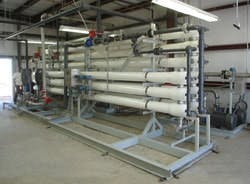Reducing Arsenic, Fluoride with RO
In the U.S., much of the Southwest suffers from high levels of naturally occurring arsenic in its groundwater. This is especially true 3 miles north of the U.S.-Mexico border in the village of Columbus, N.M. Even before regulatory limits for arsenic were reduced in 2006, Columbus was barely below the 50 µg/L bar. With a whopping 47.8 µg/L of arsenic in its raw water and a revised regulatory climate that required a maximum contaminant level (MCL) below 10, Columbus was nearly five times above the new MCL.
But that wasn’t all. Columbus also had fluoride levels of 6.9 mg/L, higher than the U.S. Environmental Protection Agency’s (EPA) MCL of 4.0 mg/L.
With an estimated population of 1,765 and an average household income of $13,773, the necessary funding to bring compliance to the drinking water was a sticking point, so the project was funded by a USDA Rural Development Grant.
Using Layne’s 40,000-sq-ft fabrication facility in Lakeland, Fla., the Membrane Group designed and fabricated all process equipment including a duplex cartridge filter skid, RO skid, raw water blending station, duplex product water transfer pumps, clean in place (CIP) skid, neutralization pump skid and three chemical feed systems. The chemical feed systems include anti-scalant, sodium hypochlorite and corrosion inhibitor. The company also provided the 3,000-gal product water and neutralization water tanks. The controls, PLC programming and motor control center were also part of the scope.
The new RO plant was commissioned on April 7, 2008. Now fully operational, the new RO system produces 255 gal per minute (gpm) of RO permeate water, while the concentrate is diverted to the municipal wastewater treatment plant. Based on performance testing data, RO permeate is 0.25 µg/L for arsenic and 0.15 mg/L for fluoride. Raw water is blended in at a specific ratio to maximize water production and to maintain arsenic and fluoride levels in compliance with the Primary Drinking Water Standards established by the EPA.
| Related Searches from WaterInfoLink.com Arsenic Removal | Fluoride | USDA Rural Development Grant | Reverse Osmosis | Layne Christensen Company | Columbus, N.M. |
